Forum Replies Created
-
AuthorPosts
-
 Robin LeadbeaterParticipant
Robin LeadbeaterParticipantHi Roger,
Spectra can only rule out or support the microlensing hypothesis, not confirm it. (Any changes in the spectrum would have indicated a potential alternative cause of the brightness change) but yes I am happy for my spectra to be included in a paper/article for the JBAA and I can supply a paragraph of explanation. (I will leave it to others to judge its merit as I have little knowledge of the subject)
Cheers
Robin
 Robin LeadbeaterParticipant
Robin LeadbeaterParticipantHi Roger,
I saw a comment suggesting a Be star on the TNS discovery entry where it is AT2021ziw. I uploaded my spectrum there to eliminate that suggestion
https://www.wis-tns.org/object/2021ziw
but at the time the gaia team uploaded their discovery there it had only brightened by around 0.4 mag so I would have said the possibilities were pretty wide open at that point. That’s why a spectrum is useful.
Not sure why a brightening Be star would be singled out as a likely possibility, (there must be many mechanisms that can produce such an upward drift in brightness) but my first spectrum clearly eliminated that possibility and that given it looked like a pretty average K class star, probably many other alternatives. The shape and symmetry of the light curve now pretty much seals it as microlensing and my second spectrum supports that. (Only a microlensing event or eclipsing binary would be expected to leave the spectrum unchanged through a significant change in brightness)
I see there is now another spectrum in TNS, taken using the 3.8m Seimei telescope. Although higher resolution the features are the same as in my spectra. (There is a bit of difference in continuum slope, possibly down to my choice of reference star.)
Cheers
Robin
 Robin LeadbeaterParticipant
Robin LeadbeaterParticipantIt has now faded ~1.3 mag since the previous spectrum and there has been no significant change, supporting the microlensing hypothesis.
Cheers
Robin
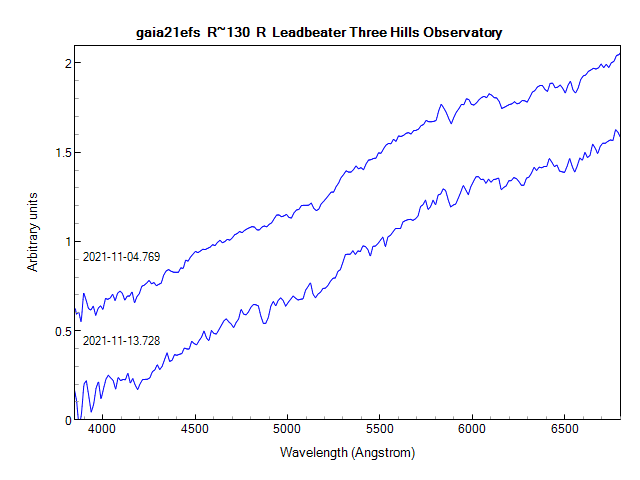
 Robin LeadbeaterParticipant
Robin LeadbeaterParticipantNow confirmed spectroscopically as Ia, by ePESTO and by the amateur 2SPOT team using their remote ALPY600 spectrograph in Chile (Image and spectrum on ARAS forum)
The spectrum does not look obviously reddened so it may be heading for being one of the brightest SN for some time
Cheers
Robin
 Robin LeadbeaterParticipant
Robin LeadbeaterParticipantIt is slightly strange that they decided to use a subset of all the available spectra (There are currently 104 in the BAA, 392 in the ARAS and 113 in the AAVSO databases, most of which would meet the resolution criterion though many are likely duplicates) I wonder what the selection criterion was.
 Robin LeadbeaterParticipant
Robin LeadbeaterParticipantThe spectrum matches that of a highly reddened early K type star
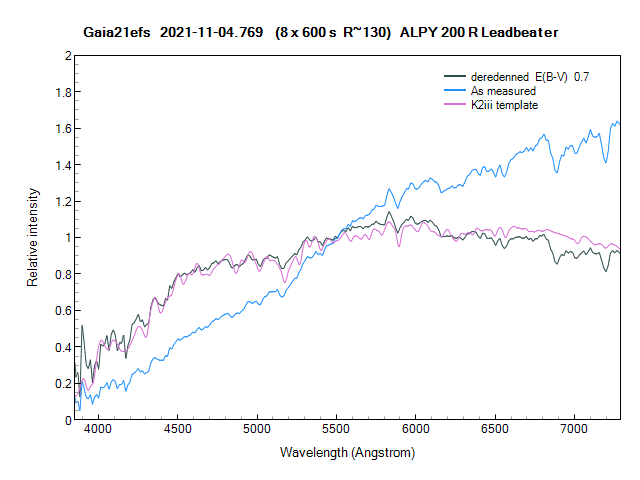
 Robin LeadbeaterParticipant
Robin LeadbeaterParticipantOn it now with the ALPY200. I make it roughly mag 13.5 unfiltered off the spectrograph guider so significantly brighter than at quiescence.
EDIT: I see that is consistent with the 13.64 V (APASS) at 16:20 today in the Gaia follow up data
 Robin LeadbeaterParticipant
Robin LeadbeaterParticipantThey used to be even smaller I think (AstroTech 65mm/70mm refractors) They also had at least one with a Star Analyser 200 in the filter wheel which Arne Henden and I sorted. Unfortunately that does not work well with the new Takahashi E-180 astrographs which at f2.8 are too fast for the SA200
 Robin LeadbeaterParticipant
Robin LeadbeaterParticipantRaising the public profile through funding permanent BAA sponsored exhibits promoting the role of amateurs in science museums and similar venues perhaps? Or perhaps taking a stake in the rebuilding of the Galloway Forest Dark Sky Observatory which (was) burnt down earlier this year?
 Robin LeadbeaterParticipant
Robin LeadbeaterParticipantand we have a member with expertise in this area
 Robin LeadbeaterParticipant
Robin LeadbeaterParticipantA remote spectrograph in the southern hemisphere could be productive and is not something that the existing “telescopes for hire” provide. There is 2SPOT, a proof of concept dedicated remotely operated spectrograph on a telescope farm in Chile run by an amateur group, funded from commercial donations, individual personal investment and crowd funding. (The equipment was shipped out and commissioned on site and is maintained locally)
 Robin LeadbeaterParticipant
Robin LeadbeaterParticipantI see fellow amateur supernova classifier Claudio Balcon took a spectrum last night and classified as a CV (with a blue continuum and weak Balmer absorption at ~0 redshift)
 Robin LeadbeaterParticipant
Robin LeadbeaterParticipantYes I saw that this morning. It is a pity it took 10 hours to report. It was clear here last night so could have grabbed a confirming spectrum.
 Robin LeadbeaterParticipant
Robin LeadbeaterParticipantLooking at the full paper, I see that they found deconvolving the images using the actual measured stellar point spread function gave artifacts so they resorted to tuning the PSF using a parameterised function. The reference to the validation of the technique using Vesta might be interesting for planetary imagers.
 Robin LeadbeaterParticipant
Robin LeadbeaterParticipantWell let’s just say i’ve seen a lot worse ! It would make a good template for anyone considering undertaking a similar sort of project
Cheers
Robin
 Robin LeadbeaterParticipant
Robin LeadbeaterParticipantDespite poring over the radar maps looking for gaps between the rain showers I have only managed 10 min on this so far.
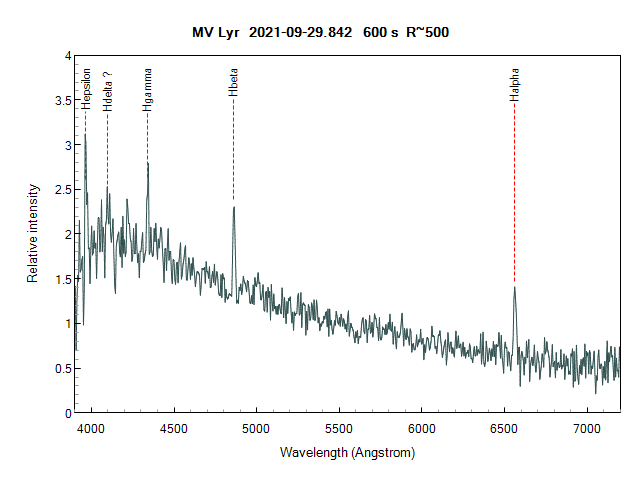
Only the Balmer lines in emission are clear in the noisy spectrum but it does perhaps seem to be intermediate between the low and high state spectra in the literature. Here for example in the high state from L. Rosino et al 1993 PASP 105 51
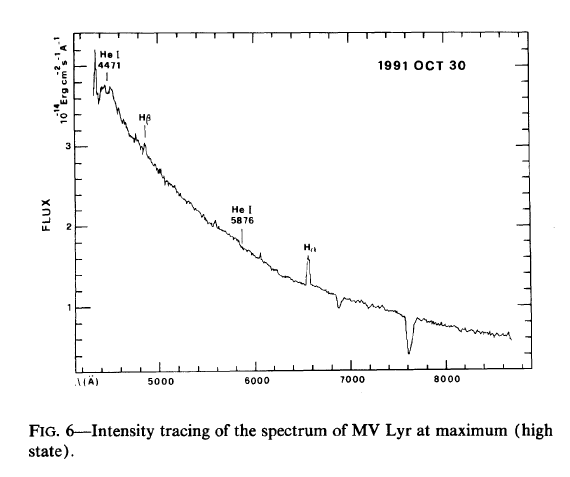
and the low state (blue end only) from Voikhanskaia, N. F. 1988, A&A, 192, 128
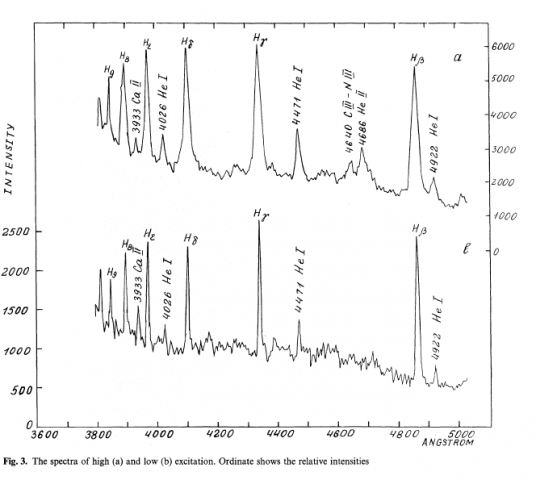
(Both low state spectra, showing interesting variation during the 0.13 day orbit)
Cheers
Robin
 Robin LeadbeaterParticipant
Robin LeadbeaterParticipantWow ! 🙁 Can you even insure against such an event ?
 Robin LeadbeaterParticipant
Robin LeadbeaterParticipantAnother low resolution R~500 spectrum last night (low SNR due to bright full moon) continues to show no evidence of H alpha (in emission or absorption) but the higher Balmer absorption lines have increase in depth. V mag for the two spectra were ~12.8/13.7 (AAVSO)
Robin
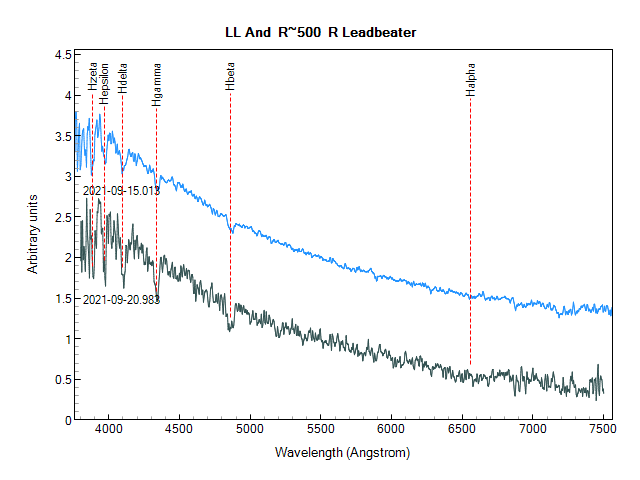
 Robin LeadbeaterParticipant
Robin LeadbeaterParticipantHi Hugh,
Looks good. I identified the coronal lines lines in a 2006 Star Analyser spectrum using this reference
This time round I’ve used ISIS to make a little animated gif (attached) showing the [FeX] line emerging based on 4 observations between 25th Aug and 11th Sept
Cheers
Robin
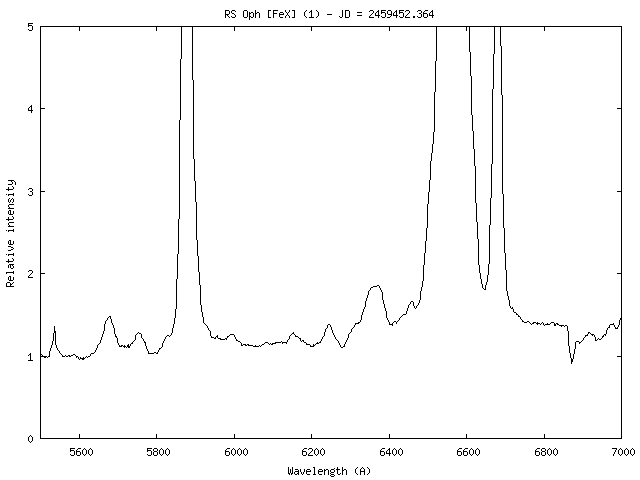
 Robin LeadbeaterParticipant
Robin LeadbeaterParticipantThe legal restrictions have been lifted but the wearing of face masks and social distancing where possible is still advised by both the government and NHS as ways to limit the spread. Personal freedom works both ways. A poll of members would be interesting. It could be that actually more members would attend provided modest precautions like face masks and social distancing were in place than would not attend because they do not wish to follow the guidelines.
-
AuthorPosts
